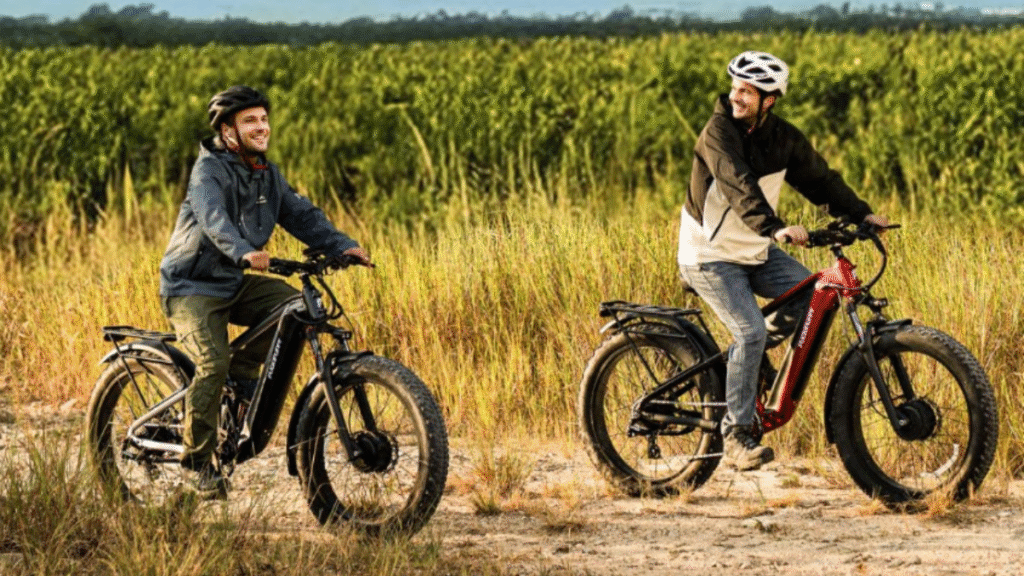There’s a special kind of magic that descends upon the trails when winter arrives. The familiar landscape transforms into a pristine, silent wonderland, where the only sounds are the crunch of snow underfoot and the whisper of the wind through frosted branches. For many riders, this marks the end of the cycling season. But for a growing number of adventurers, it’s the beginning of the most exhilarating time to ride. The secret? A purpose-built off-road e-bike that turns the challenges of snow and ice into a unique and unforgettable riding experience.
Gone are the days of hanging up your helmet at the first sign of frost. With the right electric bike, winter becomes not an obstacle, but an invitation to explore nature in its most serene state. This guide will walk you through the essential features that make an e-bike a capable winter warrior and help you choose the perfect model to conquer the cold.
The Anatomy of a Winter-Ready E-Bike
Not all electric bikes are created equal when facing winter’s harsh conditions. Specific features transform a fair-weather friend into a reliable all-season explorer. Here’s what to look for:
- Unshakable Traction: Your Connection to the Trail
The foundation of winter riding confidence lies where rubber meets the road—or rather, where specialized rubber meets snow and ice.
- Fat Tires for Flotation: The first line of defense against deep snow is a wide contact patch. Fat tires (typically 4.0 inches wide and above) act like snowshoes for your bike, providing crucial flotation that prevents you from sinking into soft powder. This wider profile also offers significantly improved stability on uneven, snow-covered terrain.
- Studded Tires for Icy Confidence: While fat tires excel in snow, sheer ice requires a more aggressive solution. Studded tires, like the PUCKIPUPPY Winter Studded Series, are the ultimate game-changer for icy conditions. These tires feature dozens of small, tungsten carbide studs that protrude from the tread, biting into hard-packed snow and glare ice with astonishing effectiveness. They provide the kind of grip that makes riding across a frozen lake or an icy uphill section not just possible, but genuinely enjoyable and safe.
- Aggressive Tread Patterns: Beyond width and studs, a deep, open tread pattern is vital for self-clearing. It prevents snow and mud from balling up in the tire, ensuring consistent contact and cornering grip in slushy conditions.
- Power and Endurance: Conquering the Cold
Winter riding demands more from both you and your bike’s drivetrain. The electrical system needs to be robust enough to handle the added resistance of snow and the energy-sapping effects of cold weather.
- High-Torque Mid-Drive Motor: When you’re plowing through deep snow or climbing a slick, snow-covered incline, raw torque is your best friend. A high-torque mid-drive motor (delivering 85 Nm or more) is preferable for winter. It efficiently translates power to the rear wheel, providing the smooth, controlled force needed to keep you moving forward without wheel spin. The centralized weight of a mid-drive also improves overall bike handling.
- Long-Range, Removable Battery: Cold temperatures can reduce lithium-ion battery efficiency by 20-30%. This makes a high-capacity battery (think 720Wh or more) non-negotiable for decent winter range. Furthermore, a removable battery is a critical feature. It allows you to store the battery indoors in a warm environment before your ride, preserving its charge and capacity, and to charge it safely away from the freezing conditions that can degrade its health over time.
- Reliability and Durability: Built for the Elements
A winter e-bike must be built to withstand moisture, road salt, and repeated freeze-thaw cycles.
- Hydraulic Disc Brakes: In wet, muddy, and icy conditions, consistent and powerful braking is a safety imperative. Hydraulic disc brakes offer superior modulation and stopping power compared to mechanical brakes, and they are less affected by the contaminants and temperature fluctuations of winter riding.
- Quality Suspension: A trail covered in frozen ruts and hidden obstacles requires a good suspension system to maintain control and comfort. A bike with at least a front suspension fork (80-120mm of travel) will smooth out the harsh vibrations and impacts of frozen ground.
- Corrosion Resistance: Look for bikes with well-sealed electrical connectors, internal cable routing where possible, and frames with durable paint or powder coatings to fight off rust caused by road salt and melting snow.
Finding Your Perfect Winter Steed: A Rider’s Guide
Your ideal winter e-bike depends on your primary riding goals and the typical conditions you’ll face.
- For the All-Season Explorer: If you ride in a mix of conditions—from fresh powder to hard-packed snow—you need a versatile workhorse. Prioritize a bike with a high-torque mid-drive motor, a large battery, and full compatibility with both standard fat tires and aftermarket studded tires. This gives you the flexibility to adapt to changing trail conditions. For these riders, we recommend exploring our curated collection of all-terrain off-road e-bikes known for their robust power and tire compatibility.
- For the Deep Snow and Ice Specialist: If your goal is to tackle the deepest snowdrifts and the iciest slopes, you need a machine built for extremes. Focus on models with the highest torque ratings (95 Nm+), the widest possible tires (4.8 inches), and the most robust frame construction. To conquer the most extreme winter terrain, you need a purpose-built machine. Filter our collection for models with the highest torque and widest tires to tackle any challenge.
- For the Winter Commuter and Trail Cruiser: If your winter riding consists of maintained paths, light snow, and mixed pavement, comfort and reliability are key. Look for a bike with a comfortable riding position, reliable hydraulic brakes, integrated fenders to keep slush off your back, and a proven track record of durability. For winter commuting and leisurely trail adventures, comfort and reliability are paramount. Browse our selection of versatile off-road e-bikes that blend practical features with dependable performance for daily winter use.
Essential Winter Riding Gear and Safety Tips
Equipping your bike is only half the battle. Equipping yourself and adapting your skills are just as important.
- Gear Up: Fit your bike with full-length fenders to manage spray. Invest in a very bright headlight and taillight to combat early sunsets and flat light conditions. For yourself, dress in moisture-wicking base layers, an insulated mid-layer, and a waterproof/windproof outer shell. Don’t forget pogies (bar mitts) for your hands—they are far more effective than heavy gloves alone.
- Ride Smart:
- Keep Your Battery Warm: Store your battery indoors until the moment you’re ready to ride.
- Lower Tire Pressure: Experiment with slightly lower tire pressures (2-3 PSI below your summer norm) to increase the tire’s footprint and enhance grip on soft surfaces.
- Smooth is Fast: Adopt a smooth, anticipatory riding style. Brake earlier and more gently, and avoid sharp, aggressive turns. Your goal is to maintain momentum and control, not set speed records.
- Plan and Inform: Winter conditions are less forgiving. Always tell someone your planned route and expected return time.
Conclusion: Don’t Let Winter Park Your Adventure
Winter doesn’t have to signal the end of your trail riding season. Instead, view it as an opportunity to experience the wilderness in its most peaceful and dramatic form. A properly equipped off-road e-bike is your key to unlocking this frozen paradise, offering the traction, power, and reliability to ride with confidence.
This winter, stop hibernating your sense of adventure. Gear up, get out, and discover the profound joy of a trail transformed by snow. Explore our curated collection of top-tier winter-ready off-road e-bikes to find your perfect cold-weather companion and start a new tradition of year-round exploration.







